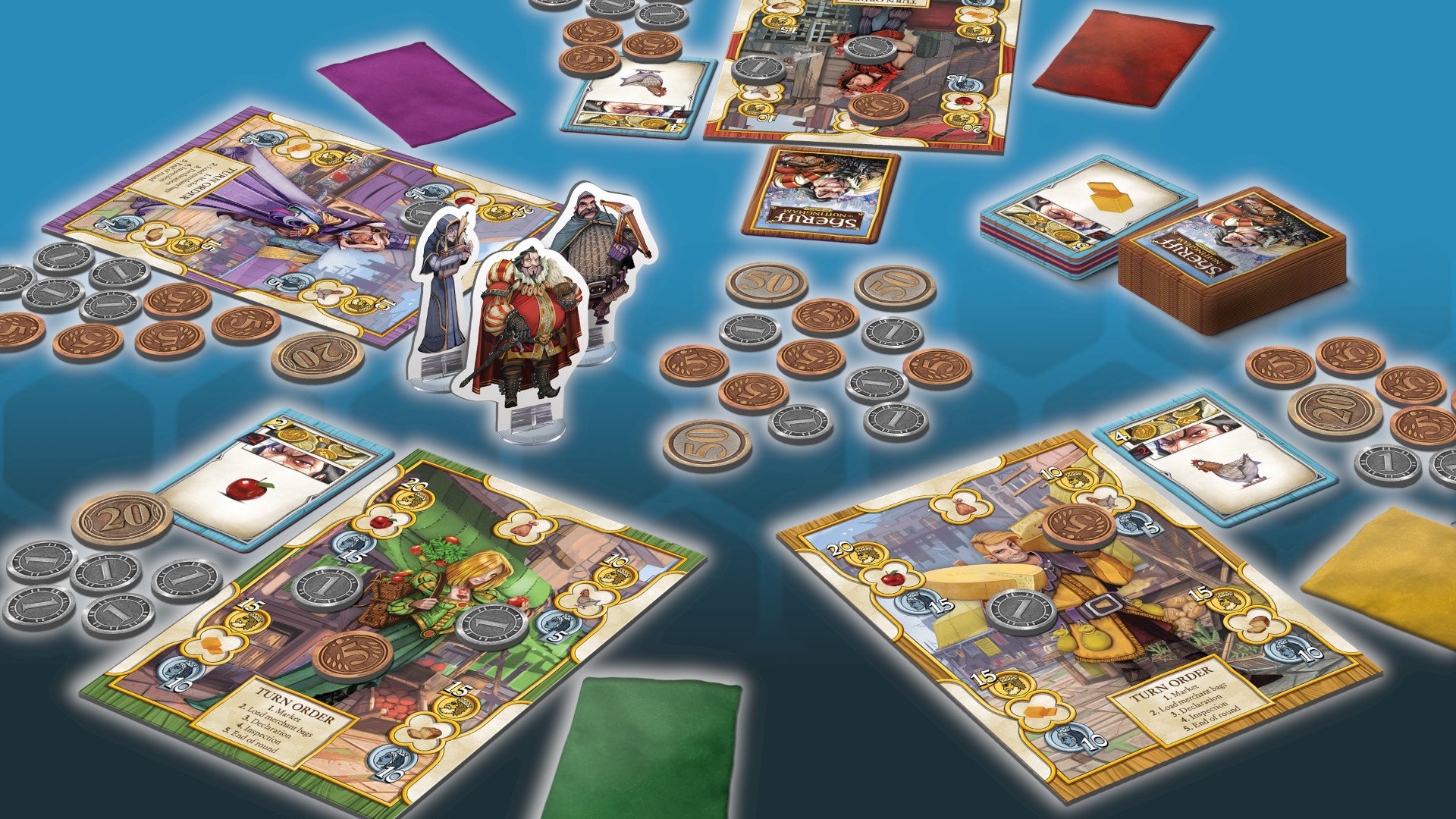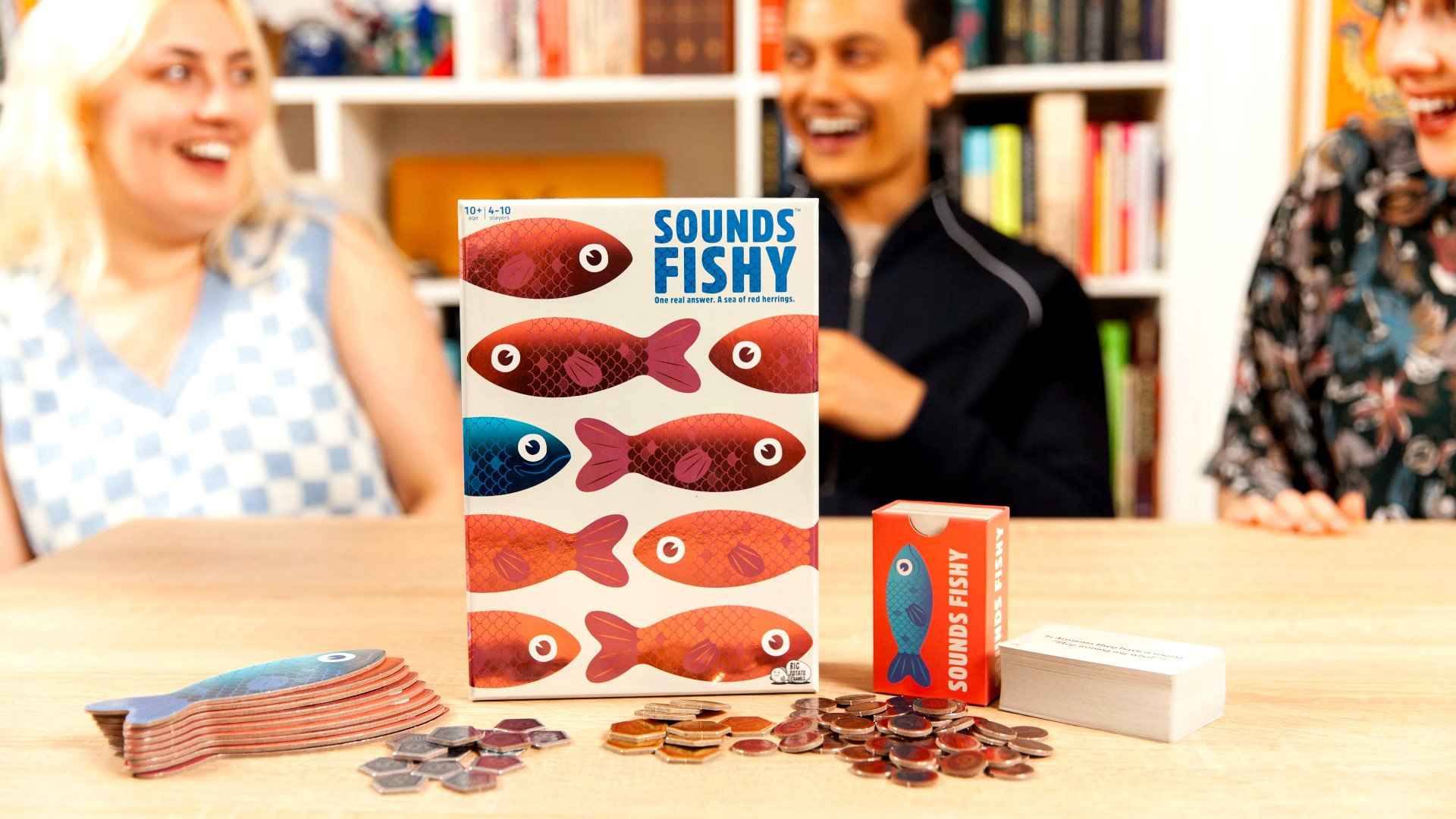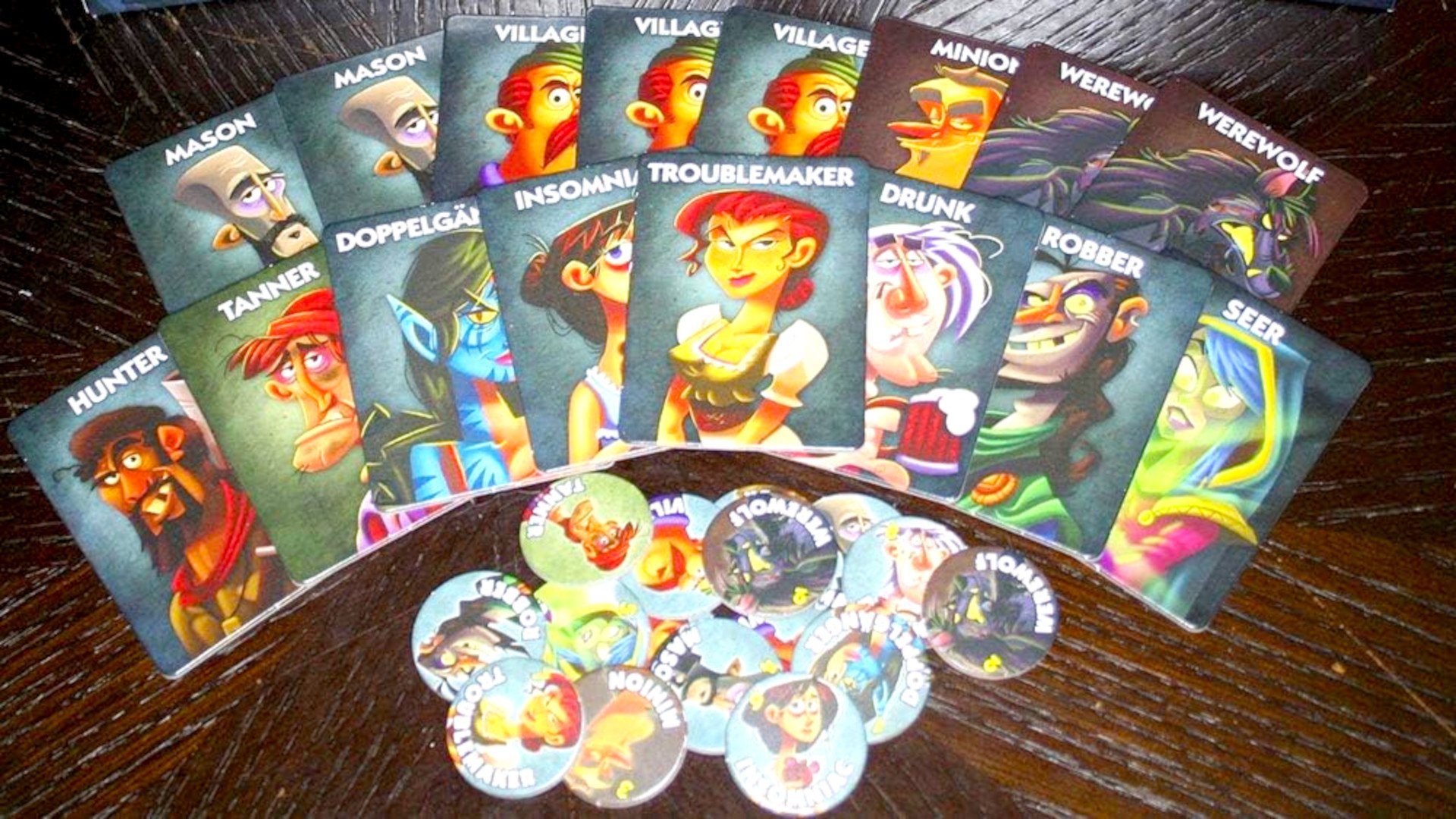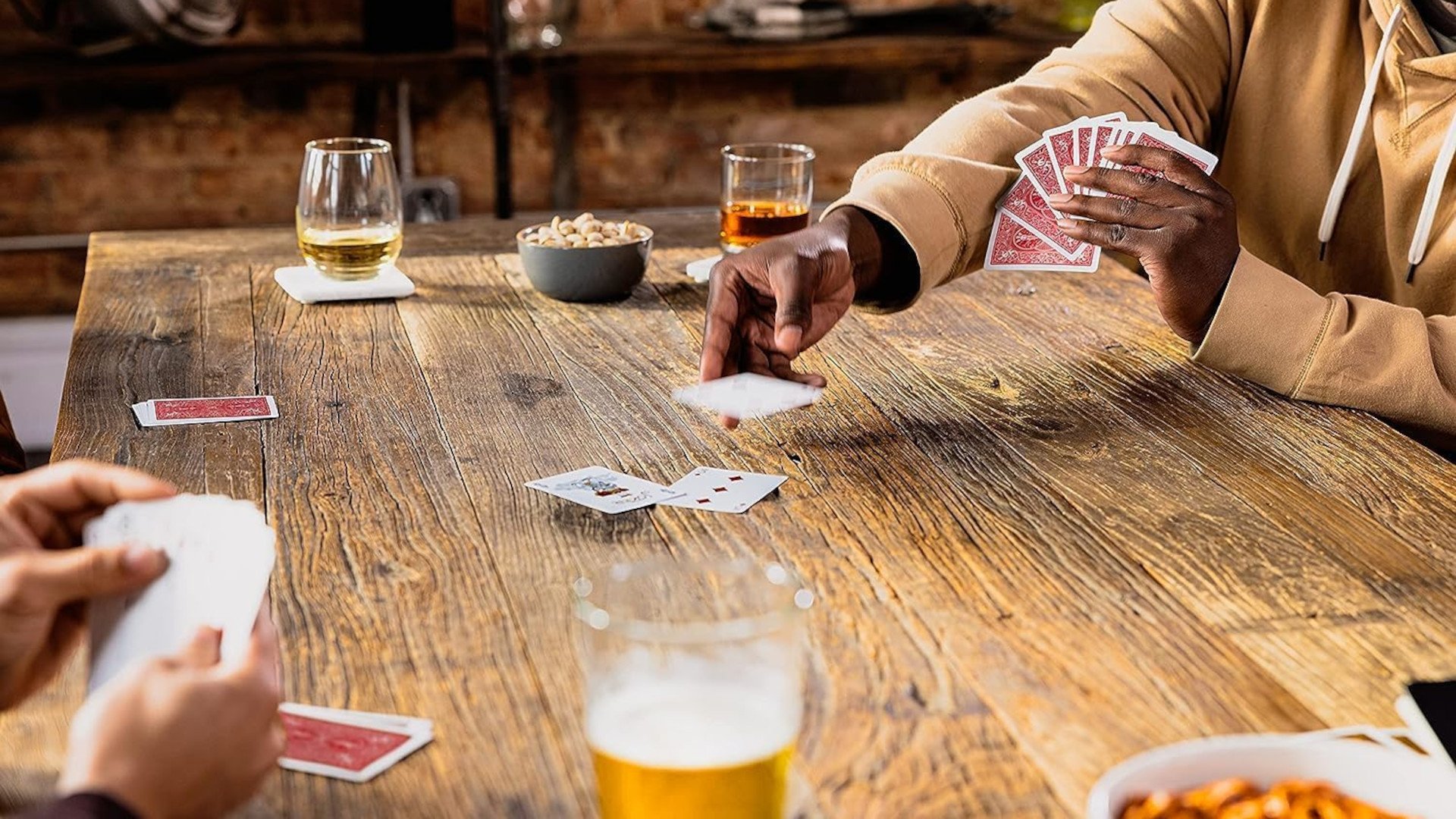Bluffing card games are as old as the hills, but they’ve stuck around so long for good reasons: it’s fun to pretend, and it’s even more fun to win at stuff by pretending better than everyone else. Why play games driven by boring math, when you can thicken the stew with human intuition, emotion, bias, and drama? We’ve played a lot of bluffing games, and we can recommend these ones as the best on offer.
Bluff is a mechanic that makes it into loads of games, but games built around bluffing are often pigeonholed as ‘casual’ or purely warm-up games. Au contraire! Some of the titles are contenders for our list of the best card games ever made; one even ranks among our best board games of all time, despite not having a board. These awesome card games span various different settings, game lengths, and player counts to suit any game session.
The best bluffing card games are:
- Coup – best for political intrigue
- Sheriff of Nottingham – best for sneaky double-dealing
- Sounds Fishy – best for creative lying
- Skull – best for tense payoffs
- One Night Ultimate Werewolf – best for parties
- Love Letter – best for quick, moreish games
- Cheat – best bluffing game using a 52-card deck
If you fancy something a bit different, we also have guides to the best two player card games and the best trading card games available. Only have a 52-card deck? Look for ideas among our favorite playing card games. For now, though, let’s get our bluffing heads on.
Coup
The best bluffing card game for political intrigue is Coup.
| Game length | 15 minutes |
| Player count | 2-6 players |
Ever wanted to be a devious, morally bankrupt, power-hungry courtier in a futuristic, tyrannical ruling class, systematically taking out your rivals until you, the lone survivor, reign supreme? Of course you have.
Indie Cards & Boards’ smash hit Coup casts you in just that role – it’s a fast-paced struggle to protect your own secret sources of political influence, while skilfully using them to erode your opponents’.
Each game, you get just two cards, face down, which represent your secret allies in the court: it could be the Duke, the Assassin, the Captain, the Ambassador, or the Contessa, in any combination.

These two cards represent your influence – your ‘lives’, essentially – and each has a unique ability; some are active moves; others block rival players from completing actions. Your goal is to destroy the other players’ influence by forcing them to turn one of their cards face-up, revealing more information to all surviving players as you go.
Here’s where the bluffs come in: when you use one of your characters’ actions, you don’t show the card to prove you have it; you just claim you have it. If another player thinks you’re bluffing, they can challenge you – if you don’t have the card; you lose an influence and flip one of your cards; if you do, they do the same.
Each turn, you’ll choose one of four actions: you can innocently claim one coin of Income; you can claim two coins as ‘Foreign Aid’ (but this can be blocked by the Duke); you can claim to have a character and use its action; or (if you have 7 coins) you can launch a Coup to immediately cause another player to lose 1 influence.
The result is one of the best, possibly the best, pure-bred bluffing game ever designed: will you play it safe, quietly rack up coins and win by coups – or will you go on the offensive, weave a web of lies, and try to flush people out? The gameplay’s sharp; it’s quick to learn and play; the sci-fi art is fun; and the price tag is teeny – Coup is an essential game.
Sheriff of Nottingham
The best bluffing card game for sneaky double-dealing is Sheriff of Nottingham.
| Game length | 60 minutes |
| Player count | 3-6 players |
At their heart, bluffing games are about telling a lie and getting away with it – sneaking untruths past your opponents – so what better setting for that than smuggling goods into a town while dodging the law?
In Sheriff of Nottingham, you play a merchant, just trying to scratch a living in the hard-bitten medieval England of the Robin Hood legend. The titular, tyrannical Sheriff is always keen to line his pockets, whether it’s by fining people for smuggling contraband, or taking hefty bribes to let them pass scot-free.

Each round, one player temporarily takes up the role of Sheriff, while the others take turns to draft cards from two shared discard piles, trying to scoop the highest value bundle of goods to take to market.
There are various legal goods, but also contraband cards, which will score much higher if you can get them through customs – you collect points at the end of the game based on the total value of everything you’ve brought into town and placed on your merchant stand.
Once you have your selection, you’ll place one to five cards in a sealed bag, which you’ll be trying to get past the Sheriff. Before you can get to market, though, you must declare to the Sheriff what’s in your bag – and, of course, it’s up to you how truthful to be.
Once everyone’s declared, the Sheriff can choose to inspect each and every bag – or they can make all kinds of deals with players to accept the bag without inspection, for a price. If they inspect your bag and you were lying, all the goods you lied about are discarded, and you’ll pay the Sheriff a gold fine for any contraband. If you were truthful, the Sheriff pays you gold compensation for each item.
The joy of Sheriff of Nottingham is that there are many layers to the deception. You have to declare that only one type of good is in your bag, whether that’s true or not – so appearing to have collected a set of matching cards in the drafting stage will make you look more honest (even if what you actually put in the bag is nothing of the kind).
And any amount of underhand sneakery is allowed when convincing the Sheriff to let you pass: everyone has some gold to use for bribes, but you could also offer them goods from your bag or your merchant stand, or promise them special treatment when it’s your turn to be Sheriff. But if it turns out those promised Chickens weren’t actually in your bag, you don’t have to hand them over – and you’re free to renege on any future promises. Hey, that’s business, right?
Sounds Fishy
The best bluffing card games for creative lying is Sounds Fishy.
| Game length | 30 minutes |
| Player count | 3-6 players |
The creation of party board game maestros Big Potato Games, Sounds Fishy is a trivia game with a bluffing twist. The box contains a pack of 200 trivia question cards, with the correct answer on the back of each card, 80 tokens for tracking points, and nine cardboard fish with one side plain, the other colored – eight red herrings, and one blue.
Each round, one person acts as guesser, hands each other player a fish, colored-side down, then reads out a question card. The fish-holders, who can all see the answer, must then dredge up a convincing fake answer to fool the guesser – all except the person with the blue fish, who has to give the true answer. The guesser, of course, needs to sniff out who’s telling the truth.

What gives this fish soup some added spice is the push-your-luck element in the guessing, though: you’ll make your guesses one by one, trying to eliminate the liars. For each red fish you reveal, you’ll gain a point, and at any time you can call it a day and bank those points. If one of your guesses turns out to be true, however, you’ll lose the lot.
Meanwhile, anyone whose red herring remained undiscovered gets points equal to how many fish got flipped in the round – so the better your lie, the more you score. It’s neat, quick, and dead simple – but the imaginative element, and the ever-present potential for truth to be stranger than fiction, makes Sounds Fishy an ingenious, replayable bluffing party game to rank with the best of ’em.
Skull
The best bluffing card game for tense, exciting payoffs is Skull.
| Game length | 20-30 minutes |
| Player count | 3-6 players |
Skull – also known by its earlier title Skull and Roses – is a bluffing game that’s as visually joyful as it is simple to learn, shockingly tense, and satisfyingly illustrative of the common saying ‘everything’s coming up roses’.
Everyone gets a square player mat and a (secret) hand of four gorgeously illustrated, circular cards – three with roses on, one with a skull. Each player lays one card face-down on their mat, and then the real game begins.
You’ll take turns to place one face-down card on top of the one(s) already on your mat, until someone decides to take the plunge and challenge (i.e. bet) that they can flip a certain number of cards without revealing a skull – starting with all their own cards.
You don’t just start flipping, though; this begins a bidding war, with each player, in turn, electing to either pass (pushing their face-down stack into the middle) or bid higher, claiming they can reveal more cards without seeing a skull.

Once all but one player has passed, the highest better has to meet their own challenge, first flipping all their own cards, then selecting other stacks to reveal from, one by one, from top to bottom. If they make it, they win! If they flip a skull, they die. Nah, not really, they just lose.
What makes Skull so excellent is its the sheer level of excitement it can generate, for a game with such simple rules and so few components. The card laying strategy isn’t very complex – either lay your skull early and set yourself up for a bigger bet, and a better chance of winning, or set it high, as a trap for others.
The real guts is in the betting – looking your rivals in the eye and thinking: ‘do they really have it in them?’ It’s pure Big Bluff Energy, and we love it.
One Night Ultimate Werewolf
The best bluffing card game for parties is One Night Ultimate Werewolf.
| Game length | 10 minutes |
| Player count | 3-10 players |
If you haven’t played Bezier’s classic One Night Ultimate Werewolf, we’re prepared to bet you’ve played one of the myriad versions of the cult party game it’s based on: Werewolf a.k.a. Mafia (Wikipedia says it was invented in Russia in 1986, but we reckon the rules were probably first inscribed on a cave wall in humanity’s earliest days).
That’s the world’s most popular social deduction game (arguably these days it has competition from the likes of Among Us and Codenames, but the whole new genre owes its existence to Mafia/Werewolf) – and ONUW is the best published version of it, hands down. It condenses the usual gameplay – where the group plays multiple rounds, with players dying every round – into one concentrated, intense burst of bluff and deduction.

In ONUW, everyone gets a secret role card dealt to them: Villager, Werewolf, or a special character with a unique ability. Depending on your role, you’re on one of two teams: Villagers and Werewolves. The game lasts just 10 minutes or so (one day in the game) – in that time, the Villager team must deduce who at least one Werewolf is, then successfully win a vote (among all players) to kill them. At the end, roles are revealed – if the dead person was a Werewolf, the Villagers win; if not, it’s party time in Full Moon City.
It’s fast, but still packs in every bit as much tense teamwork, information brokering, careful timing, subtle deception, and human drama as the full-length variants. If you’re trying to design the best bluffing game ever, you can’t do it without understanding – and outdoing – One Night Ultimate Werewolf.
Love Letter
The best bluffing card game for quick, moreish games is Love Letter.
| Game length | 20 minutes |
| Player count | 2-6 players |
You want to woo the princess. Of course you do; who wouldn’t? She’s beautiful, mysterious, and very, very rich. The problem is, everyone else wants to court her too, and they’re not keen on your competition. Only by getting your sweetly worded love letter into the hands of a senior royal, close to the princess’ ear, can you ensure your entreaties reach her before your rivals’ do.
This is the set-up to genius designer Seiji Kanai’s Love Letter, a bluffing card game where you only ever hold one or two cards at a time. The deck contains 16 cards (of which one is always removed to skew the odds, or three if you’re playing with just two players). They represent the eight different royal courtiers, each with a unique ability and a number value.
The Princess herself is worth eight; the Countess seven; the King six; the Prince five; the Handmaid four; the Baron three; the Priest two; and the Guard just one. Each player starts with one random card, then take turns to draw a second off the top, and discard a card of their choice, activating its ability. Once all the cards are drawn, the person holding the highest value card wins. That’s it!

The card abilities are all useful, but they get more useful the more you know (or suspect) about what other players are holding. The higher-numbered cards’ abilities are more powerful, but high numbers also more valuable to hold onto, to increase your chance of winning.
To add spice, the highest-numbered cards are also the most dangerous to hold onto. If you hold the Princess, you’re always at risk of being forced to discard her, and instantly being knocked out. If you have the Countess, you’ll be forced to drop her if you draw the King or Prince (she hates those guys and refuses to be around them) – which immediately makes you vulnerable to anyone with a Guard, who can knock you out if they guess your card correctly.
Love Letter moves very quickly, and who wins can turn on a dime – but it’s not a game of chance at all. As you play more, you’ll learn the odds and the interplays between cards, which allows better strategy, but also makes bluffs harder to spot. It’s a delicious dance you’ll want to play again and again – even if you only planned to play one or two rounds as a warm-up for a board game.
Cheat
The best bluffing card game using a 52-card deck is Cheat.
| Game length | 30 minutes |
| Player count | 3-10 players |
Sometimes, the simplest games are the best. The splendid bluffing card games above are all cheap, but if you want an evening of doubt, deception, triumphs and despair, all you actually need is a standard deck of playing cards to play that old favorite, Cheat, a.k.a Bullshit, or I Doubt It. It’s splendid fun, and makes a brilliant drinking card game, if you’re over 21.
You can play Cheat with two, but it gets a bit unwieldy; it’s best to have at least three players, and works with up to 10 – you can add in a second deck if you want to introduce more chaos. Your objective is to run out of cards. Start by dealing out all the cards (some players may have one or two more or less, that’s OK), and take turns to lay down cards, starting on the dealer’s left.
On your turn, you must lay down one to four cards (or one to eight, if you’ve added an extra deck for spice) in one central pile, and declare that they’re all the same card type, with the first player always declaring aces. Play continues with each successive player laying cards on top of the pile, having to declare the next number up: aces, twos, threes, and so on.

We’re sure you’ve guessed by now: you can lie about the cards you lay. But each time cards are played, before the next player takes their turn, there’s a window for anyone to shout ‘Cheat!’ at you if they think you’re bluffing, forcing you to show your cards. If you lied, you take the whole pile. If you didn’t, your challenger gets them. When one person runs out of cards, the game ends and they win. That’s it.
Cheat takes 5 minutes to teach, and normally around 20-30 minutes to play – although in our experience the runners-up normally refuse to quit once the winner emerges, continuing to battle it out until they’re desperately trying to keep half a deck in their hands. It’s very funny – if you’ve never tried it, whack it out at your next party; you won’t regret it.
Made it through our whole guide without falling for any bluffs? You’re clearly a connoisseur of the tabletop – why not sharpen your acting skills in one of the best tabletop RPGs? Or put your poker face to a battlefield test with the best war board games. If you’re more interested in a laugh, check out our favorite funny card games – that should lighten you up after all that stony-faced deception and cunning.









